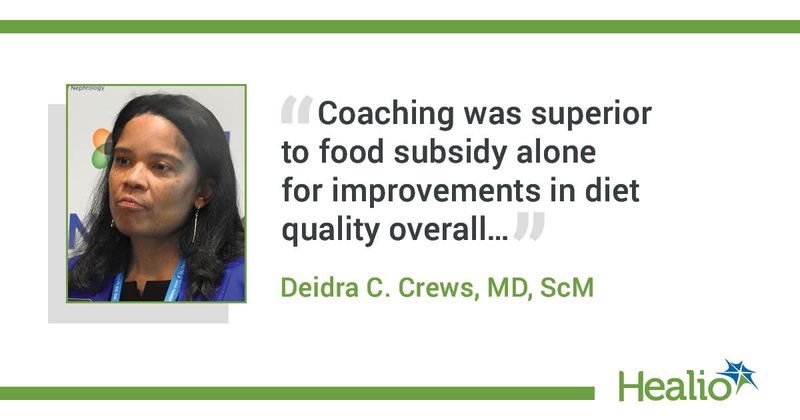Coaching improves diet quality, albuminuria in Black patients with hypertension, CKD
ORLANDO — In Black adults with hypertension and chronic kidney disease, coaching about purchasing food with high potassium improved diet quality and albuminuria, according to a presenter at ASN Kidney Week.
Coaching in addition to food subsidies led to these improvements but coaching alone remained effective, researchers said.

“Black Americans are disproportionately affected by both hypertension and advanced CKD. Suboptimal dietary patterns may play a role in these disparities,” Deidra C. Crews, MD, ScM, a professor of medicine at Johns Hopkins University School of Medicine, said in the presentation. She added, “However, many Black Americans face substantial barriers to healthy eating. They often live in disadvantaged neighborhoods and may have knowledge gaps about healthy eating and shopping within a budget.”
In a study of 150 Black adults with hypertension, urine albumin-to-creatine ratio (UACR) at least 30 mg/g and less than 1,000 mg/g in addition to an eGFR of at least 30 mL/min/1.73 m2, Crews and colleagues explored the impact of addressing some of these obstacles.
Patients were randomized 1:1 to either the Self-Shopping Dietary Approaches to Stop Hypertension (S-DASH) diet, which included a weekly allowance of $30 for 4 months with no guidance on purchases, or Coaching (C-DASH) diet with a weekly $30 allowance and assistance in purchasing high potassium foods for 4 months. After the 4-month period, the weekly allowance was removed; however, the C-DASH group continued to receive coaching.
Overall, researchers observed a greater increase in dietary potassium and fruit/vegetable consumption among the C-DASH group. A subgroup of the C-DASH patients with UACR of at least 300 mg/g experienced a 73.3% decrease in UACR, whereas the S-DASH patients had a 20.5% increase.
“We found that coaching to follow a DASH dietary pattern plus healthy food provision led to significant within group improvements in both diet quality and albuminuria,” Crews said. “Coaching was superior to food subsidy alone for improvements in diet quality overall and in albuminuria lowering among those participants who had a UACR of at least 300 [mg/g]. Future dietary interventions that incorporate coaching or health education, along with healthy food provision, may better address kidney health inequities.”

